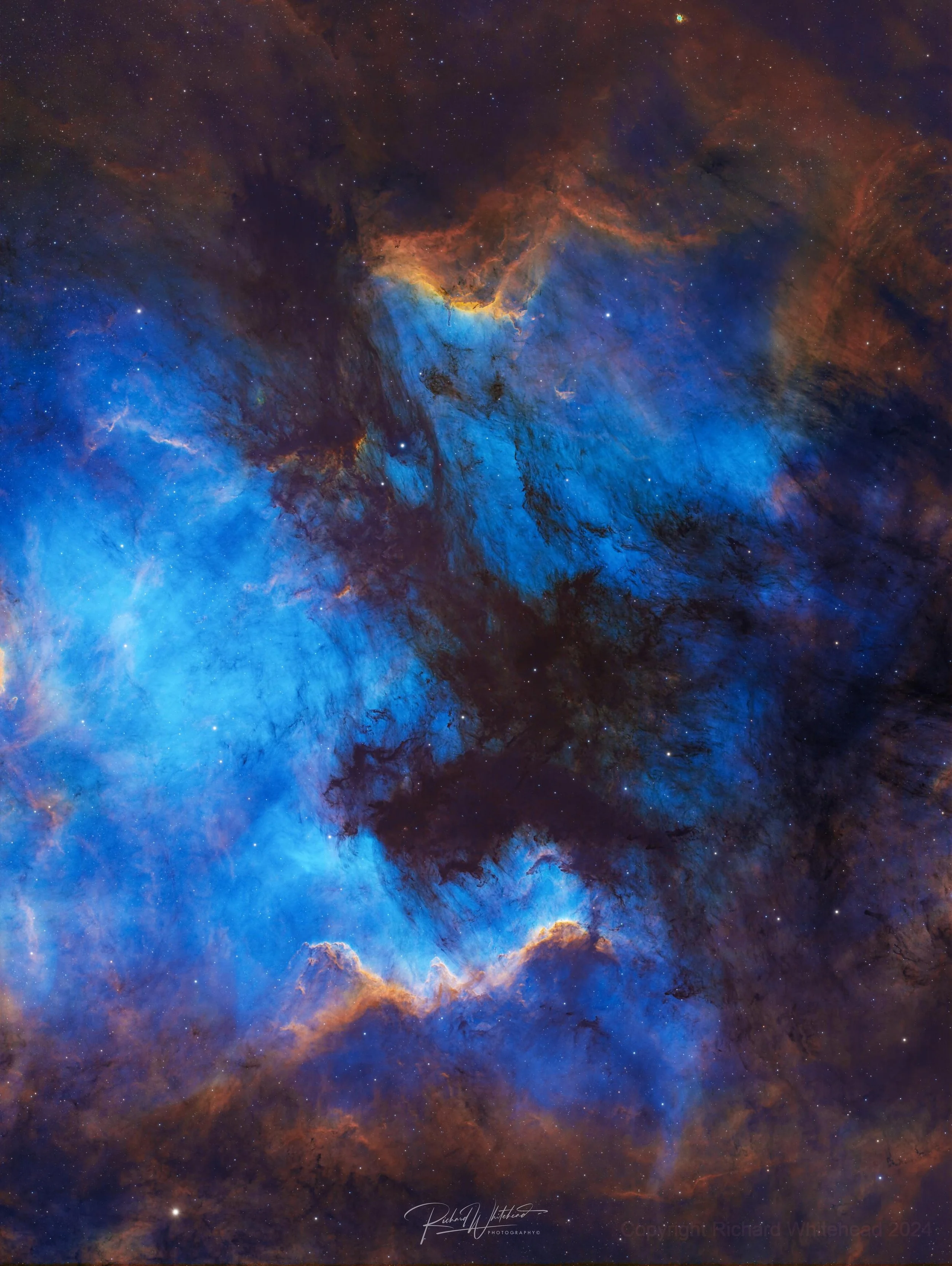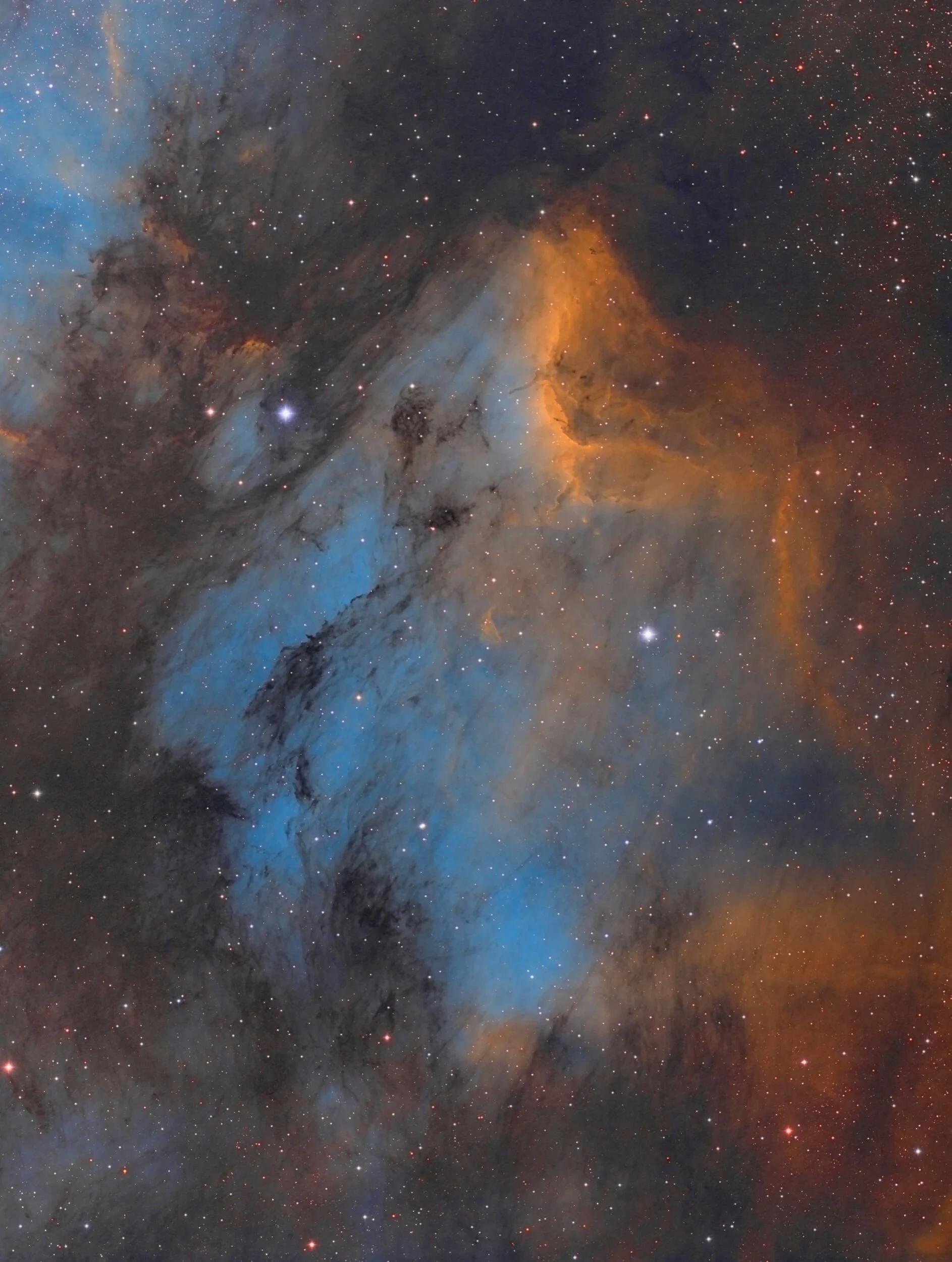
AAPOD2 Image Archives
Pelican Nebula
I originally publish this nebula image at December 2016. After that, I have shot some very high resolution material from the same area of sky and I decided to upgrade my old image with better data. I'm kind of happy with the result, especially the details in dark nebulae are much sharper now and shows the complex structures of unionized gas and dust. Main reason is the long exposure time used, for H-alpha alone, there are 30 hours of exposures. Total exposure time is around 60 hours.
The dark nebula in the upper part of the photo is the gas bridge splitting visually the Pelican Nebula and the North America nebula so that the they look like two separate nebula. In reality they are actually a one large emission area.
Technical details
Processing work flow
Image acquisition, MaxiDL v5.07.
Stacked and calibrated in CCDStack2.
Deconvolution with a CCDStack2 Positive Constraint, 33 iterations, added at 50% weight
Color combine in PS CS3
Levels and curves in PS CS3.
Imaging optics
Celestron Edge HD 1100 @ f10 with 0,7 focal reducer for Edge HD 1100 telescope
Mount 10-micron 1000
Cameras and filters:
Imaging camera Apogee Alta U16 and Apogee seven slot filter wheel
Guider camera, Lodestar x2 and SXV-AOL
Astrodon filter, 5nm H-alpha
Astrodon filter, 3nm O-III
Astrodon filter, 3nm S-II
Copyright: J-P
Pelican Nebula (IC5070)
Image Description and Details :
Tak FSQ-106ED F/5
SBIG STF-8300M
Astrodon S-ll, H-a, O-lll each 5nm 36mm 600sec x 21, 1bin
Orion CT80 + ZWO ASI 120mm mini
FLI Atlas Focuser
Skywatcher EQ8 mount (with EQ Drive standard4 TCS)
Copyright: Kim Young-Dae
Pelican Nebula and surroundings
Image Description and Details :
Scopes used:
AP175 (DSW, New Mexico) H,S,O;
RCOS 14.5 (DSW, New Mexico) HSO
DreamScope 16 (ATOE, New Mexico) LHRGB
Total exposure (used): 52.7 hours
Image width: almost 1 degree
Tools: PixInsight, Topaz, Skylum, ACDSee, SWT
Copyright: Alex Woronow
IC 5070/5067 - The Pelican Nebula
Image Information:
Observing Location: backyard, Las Vegas
Sky Conditions: Bortle zone 9
Object's Name or Designation: The Pelican Nebula
Telescope or Lens Used: Meade 115mm APO Astrograph
Camera: ZWO ASI 1600MM
Filters: Ha + Oiii + Sii
Exposure Time(s): 10 minutes per shot. 20 hours and 20 minutes total.
Special Techniques Used: Autoguiding (when it worked, half of the time)
Processed in Pixinsight
Other Comments or Description:
This image shows the bright and busy Pelican Nebula in Cygnus. There are lots of dark clouds visible in the image, as well as streaks of fainter clouds all throughout.
In “front” of the Pelican, near the bottom right can be seen several “Herbig-Haro” objects, which are jets of gasses and other matter being ejected at hundreds of miles per second by the newborn stars. One of the visible ones in the photo (the long thin pillar on the right of the blob) shows HH 555, the most active Herbig-Haro object in the Pelican Nebula.
These objects, when colliding with the surrounded dust of the nebula, create gigantic bright shock waves. These jets will disappears over time as they disperse in space.
Copyright Information: Antoine Grelin - Galactic Hunter
Pelican Nebula also known as IC 5070
Pelican Nebula ( in SHO ) also known as IC 5070 is a large area of emission nebula in the constellation Cygnus, close to Deneb. It bears a resemblance to a pelican, hence its name.
The image was taken during 4 nights and is a total of aprox. 11h of data.
Equipment used :
Baader Narrowband filters
Ha(7nm) - 70x300sec
Oiii (8.5nm)- 8x1200sec
Sii(8nm) - 10x1200sec
Televue Np101 telescope
EQ8_PRO Mount
Moravian G3_16200 camera
SG-4 standalone autoguider and Borg50 guidescope
Data captured with SGpro,alligned and stacked with ccd_stack 2 and processed in Pixinsight.
Location - Henlow (Bedfordshire).
IC 5067
Image Description and Details: MT 300 SkyVision F / D 3.3 Astrograph Telescope Instrument with Paracorr Type 2
Imager CCD camera QSI 540WSG, temperature -15 °, Atik GP guidance
Exposure 16 X1200 sec in H alpha, 5 x 600 sec in RGB
MaxIm DL 5 pre-treatments
MaxIm DL 5 and Photoshop CS3 processing
Conditions SQM 20.92, fairly good transparency, wind 28 km / s
The Pelican Nebula (IC 5067 and IC 5070) is an emission nebula located approximately 2,000 light years from Earth in the constellation Cygnus. It is very wide in the sky, making approximately 2.5 times the diameter of the Moon.
Copyright: Alexandre Cucculelli
The North American And Pelican Nebulae
The North American And Pelican Nebulae.
Taken with a Takahashi FSQ106 and SBIG 11000m.
45 hours total exposure.
Copyright: Wayne Jaeschke









